Author Archive
Tuesday, November 17th, 2015
Article by Noel Plumb Convenor of Forest Conservation Group ‘ChipBusters’
 Logging desecration along the Snowy Mountains Highway at Glenbog State Forest Logging desecration along the Snowy Mountains Highway at Glenbog State Forest
[Source: Aerial photo by Richard Green http://www.serca.org.au/pics/desecration.jpg – see postscript]
The Federal Coalition Government has declared the forests open for business and tried to strip World Heritage listing from Tasmanian forests to permit yet more clearfell logging and woodchipping.
It has also passed new laws adding native forest wood to the clean energy sources under the Renewable Energy Target, effectively giving the logging industry a public subsidy to burn forests for electricity.
The move potentially creates a massive new ‘woodchip’ industry as forests are felled to fuel domestic power stations and huge amounts of whole logs or pellets are shipped to North Asia for power plants and domestic heating. These changes have been strongly supported by State governments and State Forestry agencies are now scrambling to identify massive new wood resources for long term contracts to supply biomass fuel from the forests.
In NSW there are nearly two million hectares of native forests subject to intensive industrial logging and woodchip operations. The South Coast, the North Coast as well as Pilliga and other western State Forests will be likely targets for the dense hardwood eucalypt species presently not suitable for pulp making and possibly also the White Cypress Pine.
These State Forests are supposedly managed “sustainably” for both timber resource and the conservation of nature, especially the wildlife. As such they form an essential part of the biodiversity reserve system.
It is a nonsense on both counts – the State’s Forestry Corporation has overestimated the resource available and cannot meet various contract commitments. Worse, the intensive logging and clearfelling can in no way sustain the required habitat for most forest wildlife.
On the South Coast from Nowra to Eden there are less than 100 surviving Koalas after 40 years of intensive logging and woodchipping and this is just the tip of a massive biodiversity crash in our forests.
In NSW, complimentary legislation to allow forests to be burnt for electricity was passed last year and the Liberal Government is proceeding to change the logging rules all along the east coast to permit access to areas previously off limits such as rainforest and old growth remnants, streamside buffers, endangered species exclusion areas and very steep land, including cable logging for slopes over 30 degrees.
Twenty year forestry agreements (Regional Forestry Agreements) around the country are set to be renewed over the next few years and negotiations between the Federal and state Governments for renewal of the five NSW agreements have already begun. These agreements suspend almost all environmental protection laws for forests with the result that the forests have been mercilessly over logged at unsustainable supply levels and with massive damage to biodiversity. On the South Coast from Nowra to Eden there are less than 100 surviving Koalas after 40 years of intensive logging and woodchipping.
Both Federal and State Labor profess to oppose the burning of forests for electricity but Federal Labor refused to block the passage of the new RET laws allowing forests to be burnt for electricity. The NSW labor Party opposes cable logging. However, both Federal and State Labor are still in support of continuing intensive logging and woodchipping of native forests. WE have to change the position of one of the two big parties and Labor at this stage seems the best prospect.
If you would like to support the Log Off campaign to put an end to native forest logging once and for all, please contact ChipBusters at chipbusters@iinet.net.au or phone 0425 23 83 03.
Footnote
Sydney conservationist Richard Green, his wife Carolyn and passenger John Davis were found in the helicopter’s wreckage in mountainous terrain, south of Cessnock, in the Watagans National Park on Monday. The aircraft, which took off from Breeza in northern NSW on Saturday, had been reported missing on Monday after it failed to arrive at its destination, Mona Vale.

Saturday, November 15th, 2014
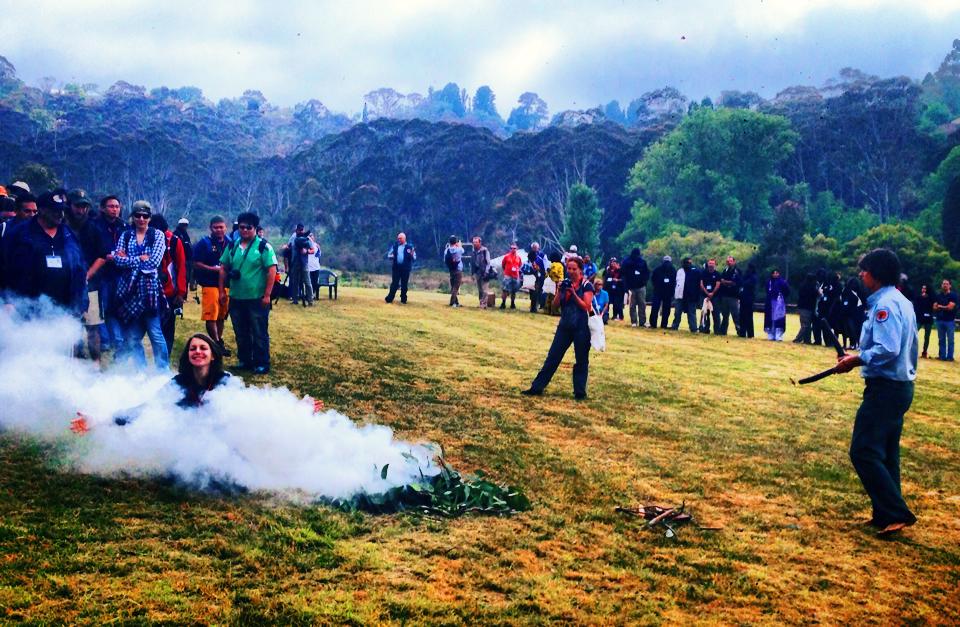 Smoking Ceremony or Smoke and Mirrors?
Staged for the delegates by National Parks and Wildlife Service of New South Wales (NPWS), somewhere outside Sydney, Australia
[Source: ‘Global First Nations environmentalists share stories at the World Parks Congress in Sydney.5:30’, ^https://twitter.com/nitvnews, 20141113] Smoking Ceremony or Smoke and Mirrors?
Staged for the delegates by National Parks and Wildlife Service of New South Wales (NPWS), somewhere outside Sydney, Australia
[Source: ‘Global First Nations environmentalists share stories at the World Parks Congress in Sydney.5:30’, ^https://twitter.com/nitvnews, 20141113]
.
Every ten years a World Parks Congress is a forum staged by the International Union for Conservation of Nature to discuss the effectiveness of World Heritage Listed Protected Areas. For 2014, Parks Australia put up Sydney’s hand to host and fund it.
<<“We (Parks Australia) are delighted to be co-hosting the IUCN World Parks Congress with our colleagues in the New South Wales National Parks and Wildlife Service – and look forward to welcoming inspiring leaders from around the world.”>>
IUCN’s vision is a “just world that values and conserves nature.” The theme for the 2014 conference is “Parks, people, planet: inspiring solutions”.
The last congress was in Durban, South Africa eleven years ago in 2003 and significant messages from that congress were that:
- Considerable progress has been made in the establishment of protected areas although significant gaps remain
- Protected areas face many challenges, and management effectiveness must be strengthened
- Protected areas play a vital role in biodiversity conservation and sustainable development
- A new deal is needed for protected areas, local communities and indigenous peoples
- There is a need to apply new and innovative approaches for protected areas, linked to broader agendas
- Protected areas require a significant boost in financial investment
- Protected areas management must involve young people
.
Congress Cost Benefits ?
.
The obvious first question for the 2014 Sydney Congress is what are the outcomes from these seven messages of 2003?
The second question is what is to be the conservation return on investment of staging the 2014 congress in Sydney? That starts with Parks Australia and NPWS disclosing the full costs of the congress. How much will it have cost by the time this week is over? Five million? Ten million? Twenty million? More? That also involves disclosure of the onground conservation outcomes, if any. The congress hosts more than 5000 delegates for a week-long event in Sydney.
If the answers are not forthcoming and/or the performances less than satisfactory, then perhaps the money could have been better spent (invested) by Parks Australia and NPWS on specific onground conservation of current and worthy Protected Areas in Australia. So the third question is what is the opportunity cost of the 2014 IUCN World Parks Congress which could have delivered the IUCN vision of a “just world that values and conserves nature”?
.
Congress Opportunity Costs
.
According to IUCN director general, Julia Marton-Lefevre, assessments during the past decade have found that half of the world’s protected areas at best — and possibly as few as 20 per cent — are managed effectively. “Some are what we refer to as ‘paper parks’ ” – parks just on paper.
The Australian Government’s $180 million allocation to expand the park reserve system expired last year.
The Great Barrier Reef Marine Park is a case in point. It is the iconic Protected Area in Australia. Its World Heritage listing along with various national zoning, management plans, permits, education and incentives are supposed to protect and conserve the marine ecosystems and migratory species from human threats. But farm and urban runoff continues to contaminate the rivers that flow into the Reef.
In 2009 and 2011, mining company Queensland Nickel discharged nitrogen-laden water and 516 tonnes of toxic waste water into the Great Barrier Reef.
On 21 July 2013, on the second day of the biennial joint training exercise Talisman Saber, two American AV-8B Harrier fighter jets launched from aircraft carrier USS Bonhomme Richard (LHD-6) dropped four bombs, weighing a total 1.8 metric tons (4,000 pounds), into more than 50 metres (164 ft) of water. On 3rd April 2010, The Shen Neng 1, a Chinese ship carrying 950 tonnes of oil, ran aground, causing the 2010 Great Barrier Reef oil spill.
In December 2013, Greg Hunt, the Australian environment minister, approved a plan for dredging to create three shipping terminals as part of the expansion of an existing coal port. According to corresponding approval documents, the process will create around 3 million cubic metres of dredged seabed that will be dumped within the Great Barrier Reef Marine Park.
On 31 January 2014, a permit was issued to allow three million cubic metres of sea bed from Abbot Point, north of Bowen, to be transported and unloaded in the waters of the Great Barrier Reef Marine Park, just outside of Abbot Bay. The dredge spoil will cloud the water and block sunlight, thereby starving sea grass and coral up to distances of 80 km away from the point of origin due to the actions of wind and currents. The dredge spoil will smother reef or sea grass to death, while storms can repeatedly resuspend these particles so that the harm caused is ongoing; secondly, disturbed sea floor can release toxic substances into the Great Barrier Reef Marine Park.
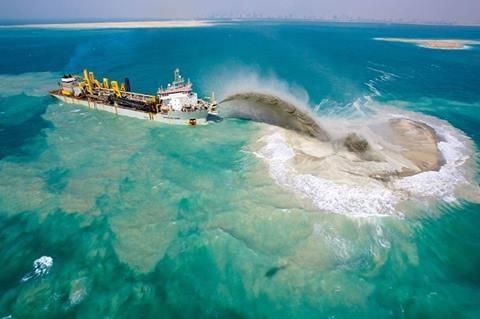 Dredging the Great Barrier Reef for bulk export shipping Dredging the Great Barrier Reef for bulk export shipping
.
The Great Barrier Reef Marine Park has become just a blue line on a map. The trickle of funds for Australia’s national parks betrays a lack of appreciation of their economic contribution. Annual funding for the authority that runs Australia’s most famous reserve, the Great Barrier Reef Marine Park, is about 1 per cent of the $5.2bn it earns the country in tourism revenue.
Yet if the IUCN World Parks Congress cost a conservative $20 million to stage then a key opportunity cost would be the June 2014 Federal budget cuts to the Great Barrier Reef Marine Park Authority.
The budget axed 17 staff including five of its’ directors positions. These positions included the director of heritage conservation, the director of policy and governance and the director of coastal ecosystems and water quality as part of an internal restructure. It’s being described as the greatest loss of expertise from Australia’s most important natural wonder and it comes at the very time the Great Barrier Reef is facing the greatest threat to its survival.
The Greater Barrier Reef Marine Park Authority has been reduced by the Australian Government to being in name only and ineffective at protecting the reef.
Until recently, one of those five directors, Adam Smith, was charged with dealing with the contentious Abbot Point coal terminal development and the proposal to dump three million cubic metres of dredge spoil into the marine park. Despite Dr Smith’s concerns, the sea dumping was approved by the Marine Park Authority.
Dr Smith has since accepted voluntary redundancy and moved on after disagreeing with the Authority’s new economic leadership and values. Heritage conservation director Jon Day has left after 21 years, disillusioned too with the direction the Authority has taken to compromise the reef.
Next year UNESCO will decide whether to put the reef on its world heritage in danger list. Native Dugongs are already endangered. The deliberate extermination of the dugong and turtles which habituated the Gladstone area is a national tragedy. Dugongs are species listed under the Federal Environment Protection Biodiversity & Conservation Act, which requires the Federal government to legally protect these animals.
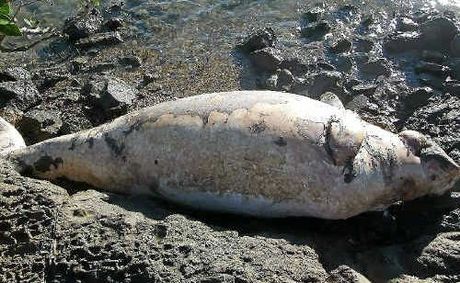
Prior to the massive dredging operation of 52 million cubic metres of seabed for the development of the world’s largest LNG Terminal, ( which is 62% completed) a study commissioned by the Gladstone Ports Corporation found that a take, or a quota, of more than zero dugongs would be unsustainable.
In the face of massive mortality of dugongs, turtles and inshore dolphins during the ongoing massive dredging, both the Federal and Queensland governments ignored the slaughter.
Look at the stranding data from the Queensland Department of Environment and Resource Management. Monthly cumulative Dugong strandings by year for Queensland, up to 31 January 2012.
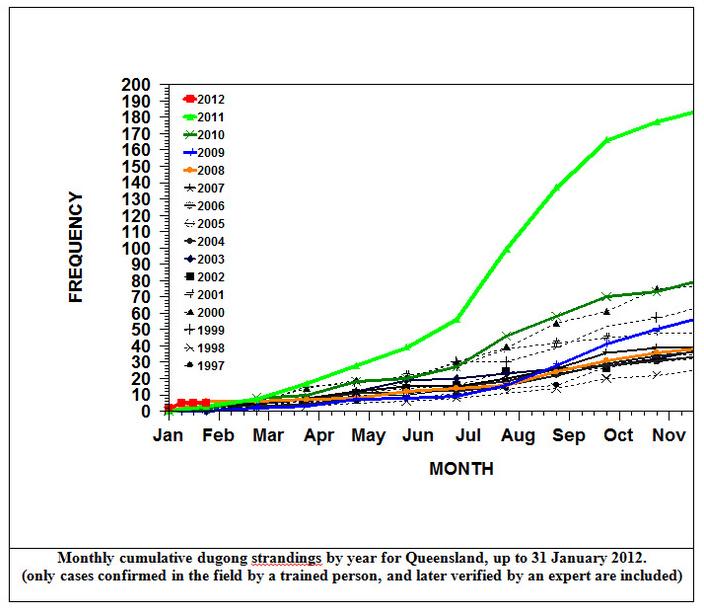
There are 22,000 vessel movements a month in Gladstone Harbour. No ship strikes of Dugongs or of Green Turtles need to be reported. No audit of environmental conditions has been undertaken by the Queensland or Federal Governments. The wholesale slaughter of our marine wildlife is the price Australians are paying for the transformation of the Great Barrier Reef World Heritage Area into the world’s largest unregulated quarry.
 Mass tourism operators good for the economy
Getting up close to protected Humpback Whales within their 100 metre Protected Area Mass tourism operators good for the economy
Getting up close to protected Humpback Whales within their 100 metre Protected Area
.
Australian protected areas have seen rule changes in the eastern states have allowed cattle to graze, recreational shooters to hunt and hotel developers to build in national parks. Shore-based recreational fishing has been allowed in areas of NSW marine parks previously zoned as no-take sanctuaries. National parks on land and in the ocean are dying a death of a thousand cuts, in the form of bullets, hooks, hotels, logging concessions and grazing licences.
Yet as host of the 2014 World Parks Congress, Australia is showcasing “our own inspiring places, inspiring people and inspiring solutions.” The Global Eco Forum within the Congress programme focuses on tourism exploitation of Protected Areas because like the new Greater Barrier Reef Marine Park Authority, the new values are not about conservation by the billions in revenue opportunity to Australia’s economy.
The October 2006 issue of National Geographic published an article “The Future of Parks: Hallowed Ground – Nothing is Ever Safe”.
It stated:
“Landscape and memory combine to tell us certain places are special, sanctified by their extraordinary natural merits and by social consensus.
We call those places parks, and we take them for granted.”
.
Sydney’s 2014 World Parks Congress appears to be expensive window dressing, showcasing fraudulent conservation of Protected Areas in Australia.
It’s termed Greenwashing. The opportunity cost of the 2014 Congress could have instead funded the retention of the previously effective Great Barrier Reef Marine Park Authority and so done more for Protected Areas than all the pomp, promising, luncheons, showcasing, and talk-festing of the congress combined.
.
 Protest to stop Queensland Resources Council dumping dredge spoil inside the Reef
Protest by Cairns and Far North Environment Centre (CAFNEC), June 2014
^http://cafnec.org.au/wp-content/uploads/2014/03/rally-promo-photo.jpg Protest to stop Queensland Resources Council dumping dredge spoil inside the Reef
Protest by Cairns and Far North Environment Centre (CAFNEC), June 2014
^http://cafnec.org.au/wp-content/uploads/2014/03/rally-promo-photo.jpg
.
Further Reading:
.
[1] IUCN World Parks Congress (Sydney 2014), International Union for Conservation of Nature, ^http://worldparkscongress.org/
.
[2] ‘Global Eco-Tourism in Protected Areas‘, by EcoTourism Australia, >2014 Global Eco Tourism in Protected Areas.pdf (1.1MB, 2 pages)
.
[3] Great Barrier Reef Marine Park Authority (website), Australian Government, ^http://www.gbrmpa.gov.au/
.
[4] Fight for The Reef (website), Australian Marine Conservation Society, ^https://fightforthereef.org.au/risks/dredging/
.
[5] No Hunting in National Parks (website), The National Parks Association of NSW, ^http://nohunting.wildwalks.com/
.
[6] ‘An international perspective on tourism in national parks and protected areas‘, by J.G. Castley (2014), >An international perspective on tourism in national parks and protected areas.pdf (100kb, 10 pages)
.
[7] ‘EXTRA: ‘Nasho’, Royal National Park, Sydney’s neglected southern jewel‘, by Nick Galvin, Journalist, Sydney Morning Herald, 20140613, ^http://www.smh.com.au/nsw/extra-nasho-royal-national-park-sydneys-neglected-southern-jewel-20140613-zs6d8.html
.
[8] ‘Paradise lost: Australia’s heritage jewels under threat‘, (audio), ABC ‘Background Briefing’ radio programme, by Sarah Dingle, 20131208, ^http://www.abc.net.au/radionational/programs/backgroundbriefing/2013-12-08/5132224
.
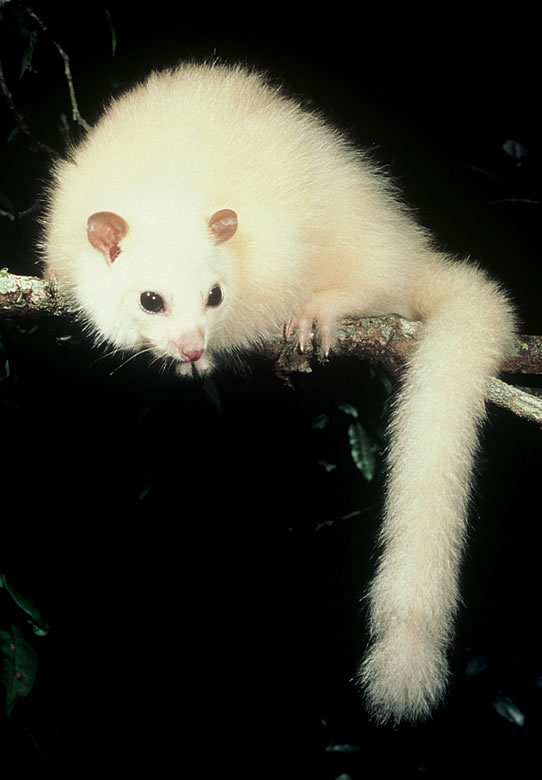 White Lemuroid Possum
(Wet Tropics of Queensland World Heritage Area in Danger)
Has the white lemuroid possum become the first mammal to go extinct due to global warming? White Lemuroid Possum
(Wet Tropics of Queensland World Heritage Area in Danger)
Has the white lemuroid possum become the first mammal to go extinct due to global warming?
The species, normally found above 1000m, has not been sighted during any nighttime spotlighting expedition since 2005. Experts fear a temperature rise of 0.8 degrees Celsius may be to blame for the animal’s disappearance.
[Source: ^http://www.wherelightmeetsdark.com/index.php?module=newswatch&NW_user_op=view&NW_id=453]
.
Tags: Dugong, Dugong strandings, Gladstone Harbour, Great Barrier Reef, Great Barrier Reef Marine Park, Green Turtle strandings, greenwashing, Humpback Whale, International Union for Conservation of Nature, iucn, national parks, National Parks and Wildlife Service, Parks Australia, Protected Areas in Australia, Queensland Government, The Great Barrier Reef Marine Park Authority, UNESCO world heritage in danger list, Wet Tropics of Queensland World Heritage Area in Danger, White Lemuroid Possum, World Heritage, World Parks Congress
Posted in Critically Endangered Wildlife (CR), Threats from Government Funding Neglect, Threats from Greenwashing, Threats from Pollution, Threats from Tourism and Recreation, Threats from Weak Environmental Laws | No Comments »
Add this post to Del.icio.us - Digg
Tuesday, November 4th, 2014
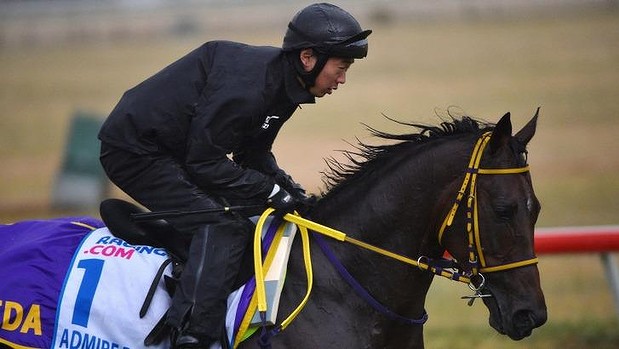 Horse ‘Admire Rakti’: dead from cruel abuse Horse ‘Admire Rakti’: dead from cruel abuse
.
A horse bred for racing and named Admire Rakti was overloaded and overwhipped in the 3,200 metre long Melbourne Cup race today.
The seven-year-old stallion, had just won the Caulfield Cup two weeks before, and so was handicapped by having 58.5 kg in weight, just to even out the betting odds.
On a hot 28 Celsius day, the horse was flogged into the race lead, then his heart gave way, finishing last, collapsing five minutes after the race and then had a heart attack, and so tragically died for sport. The race that stops a nation kills horses.
The RSPCA issued a statement calling for a full and transparent investigation.
The 30 protesters from the Coalition for the Protection of Racehorses had gathered around the main gate at Flemington Racecourse chanting “racing kills”. They were right.
The group’s spokesman Ward Young, said Admire Rakti’s death was another example of horses being overworked on the racetrack. “Racing does kills horses and we think a lot more needs to be done to make horse racing safer. These incidents are a lot more frequent than people know about.”
He said in the past year about 125 horses have died during or shortly after a race.
This time, Mr Young said they were letting racegoers know that a horse had died “because last year the only people who knew about Verema dying in the Melbourne Cup were the people who bet on her”.>>
.
[Source: ‘Melbourne Cup 2014: Last-placed Admire Rakti dies‘, by Patrick Bartley, Adam Pengilly, Ronny Lerner, The Age newspaper, 20141104, ^http://www.theage.com.au/sport/horseracing/melbourne-cup-2014-lastplaced-admire-rakti-dies-20141104-11gpjk.html]
.

.
In Nashville, USA in 2012, a horse bred to be a steeplechase thoroughbred and named Arcadius won the Iroquois Steeplechase over three miles and eighteen hurdles.
He galloped under the pain and fear of the horse whip. His owner won $150,000 from the race.
Immediately after the race, the 8-year-old gelding, breathed hard as he walked back to applause. The humans lined up, the horse was led in to the winner’s circle. Catching his breath now, he stood for the brief ceremony — a sweaty, dirty, hot, victorious athlete.
It was as if he knew he had won. Arcadius stared regally to the distance, ears at attention, and everyone else paused, soaking in the victory. The cameras buzzed. Crowley jumped down, unbuckled the elastic girths, removed the leather saddle, breastplate, black and red cloth with the white 3 on it. The jockey folded it all up on his arm, patted his horse on the back, one more reward for the effort.
Two minutes later, Arcadius was dead — steps from the finish line he had crossed with so much power, so much life.
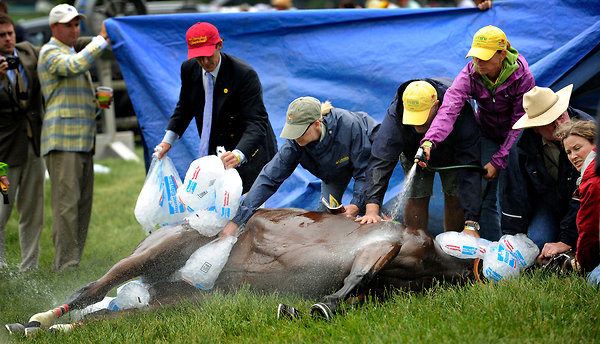 Arcadius: dead from cruel abuse, hidden from punters’ view Arcadius: dead from cruel abuse, hidden from punters’ view
.
It was quick, shocking, certainly eerie. After walking from that winner’s circle celebration, while getting the usual after-race hosing and dousing with water, Arcadius stepped awkwardly to his right, raised his head, stiffened his front legs and dropped to the ground on his left side.
Before he fell, his right eye went blank — flashing life, death, pain, something. >>
.
[Source: ‘After the Best Race of His Life, a Horse’s Death‘, by Joe Clancy, 20120514, ^http://www.nytimes.com/2012/05/15/sports/after-his-lifes-best-race-death-of-horse-arcadius.html?pagewanted=all&_r=0]
.

.
Further Reading:
.
[1] ‘Whips in Racing‘, RSPCA, ^http://www.rspca.org.au/campaigns/whips-racing .
.
[2] The Coalition for the Protection of Racehorses, website, ^http://www.horseracingkills.com/ .
.
[3] ‘Animal liberationists call for whip phase out‘, by Sherele Moody, 20141104, ^http://www.suratbasin.com.au/news/animal-liberation-group-calls-for-whip-phase-out/2442357/ .
.
[4] ‘Horse Racing – the glitz, the glamour the grim reality‘, Animals Australia, ^http://www.animalsaustralia.org/issues/horse_racing.php .
.
[5] ‘Horse Racing breeds immoral knackeries, ^https://www.habitatadvocate.com.au/?p=19982
.
Monday, November 3rd, 2014
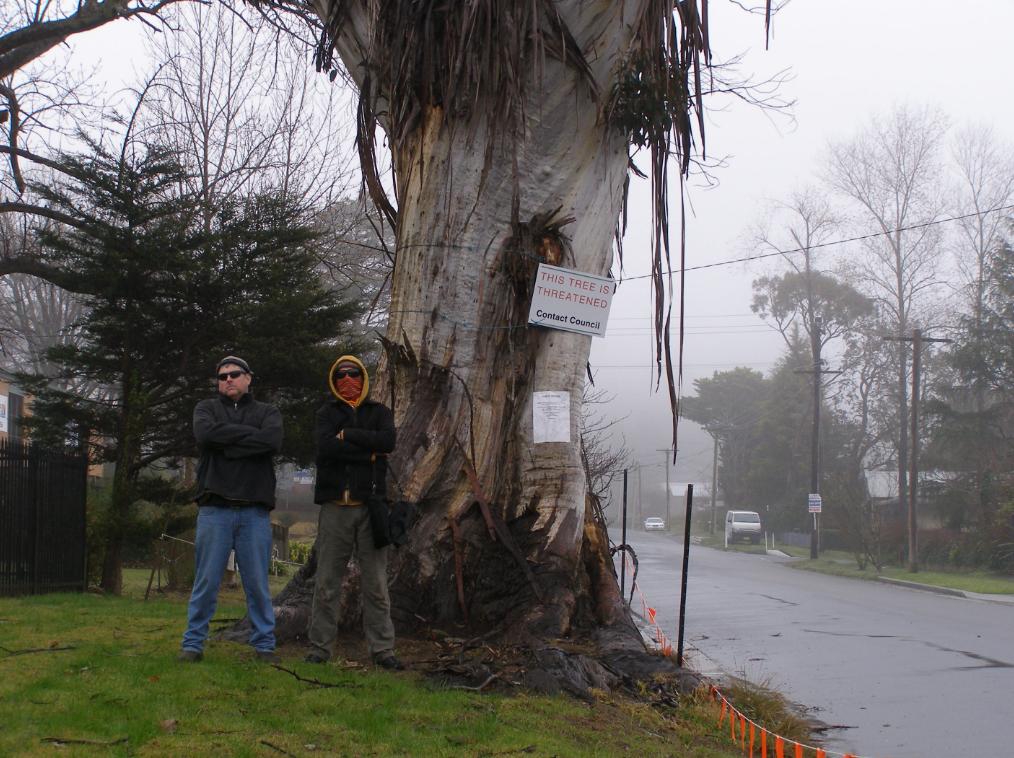 ATLAS of Katoomba
[ © Photo by Editor 20140907, Katoomba, Blue Mountains World Heritage Area] ATLAS of Katoomba
[ © Photo by Editor 20140907, Katoomba, Blue Mountains World Heritage Area]
.
At an informal community meeting at ATLAS (a 200+ year old endemic Blue Mountains Ash) today, it has been made public that Blue Mountains Council’s tree officer had been inappropriately coerced by a councillor in 2010 to have this magnificent iconic tree conveniently killed. According to the officer it is because of a (very) close association with a property developer of the adjoining site.
Fortunately the tree officer, out of respect for this heritage tree and out of respect for the rule of law and for due process, personally stood up to the councillor’s intimidation and so appropriately arranged for an independent arborist to evaluate the viable health of this tree.
That independent arborist reported that the tree was healthy and ought to be retained, and so it has.
All credit to Council’s Public Tree Officer for resolutely following due process. The developer has a track record of ignoring Blue Mountains Councils development consent conditions relating to this tree. DA consent conditions 61, 62, 63, and 68 have all been ignored or breached.
Despite Council’s requirement for Tree Protection Measures and a Tree Protection Plan, neither were supplied, yet the industrial development was allowed to proceed.
The developer has illegally lopped a healthy branch from the tree.
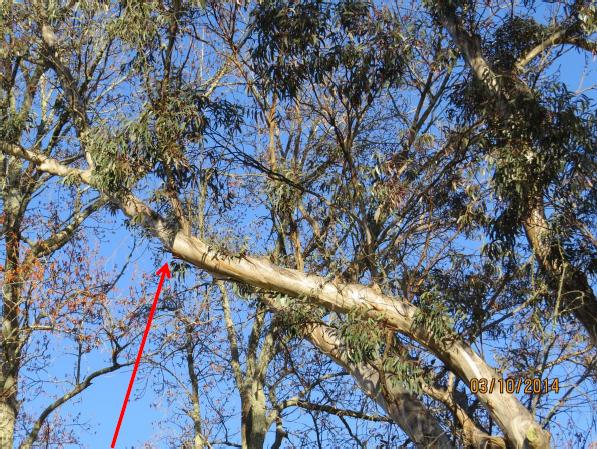 Main branch illegally lopped by the developer’s contractor without Council permission
[ © Photo by Angophora Consulting Arborist, 201410-03, Katoomba, Blue Mountains World Heritage Area] Main branch illegally lopped by the developer’s contractor without Council permission
[ © Photo by Angophora Consulting Arborist, 201410-03, Katoomba, Blue Mountains World Heritage Area]
.
The developer furnished no Tree Protection Measures, Tree Protection Plan or Tree Protection Zone. In the mind of the developer, the tree is situated on Council land after all. He knew as such and was likely told that his environmental bond was a farce.
He is correct. So this is why a string of Council bureaucrats have gone running for cover. .
Thursday, October 16th, 2014
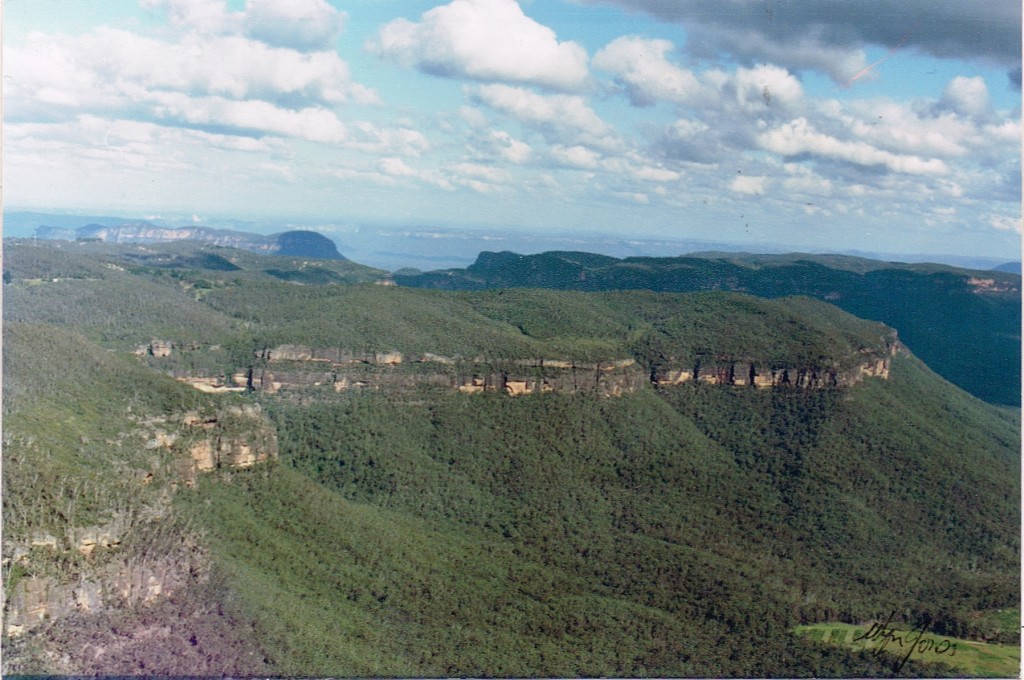 Elphinstone Plateau Elphinstone Plateau
(from Mount Mark cliff edge looking SW)
Blue Mountains World Heritage Area
[Photo Source: © Wyn Jones, circa 1991]
.
There exists a vast plateau unspoilt from the valley floor and it lies just west of Katoomba in the Blue Mountains.
It is Elphinstone Plateau, known mainly to locals and to informed bushwalkers. It’s deep gorges provide critical habitat to one of the world’s most endangered plants, Microstrobos fitzgeraldii, and to its integral waterfall spray dependent ecological community.
Elphinstone Plateau lies interconnected with the Cox’s Watershed traversing the Blue Mountains World Heritage Area, connected to National Parks owned land, to Narrow Neck and to the Jamison Valley. The photo above shows how country is interconnected in the Blue Mountains and that Elphinstone Plateau remains one of the last surviving wild places of the Central Blue Mountains area. We value it.
Elphinstone Plateau is an integral continuum of the Blue Mountains Great Southern Escarpment. Elphinstone Plateau’s uniqueness and its dependent habitat and wild values deem that it should be integrated into the Blue Mountains National Park and the Greater Blue Mountains World Heritage Area.
Elphinstone Plateau’s history contains stories, many sad and some a curse, and more recently of local community battles fought for years late into the night driven by a committed local few.
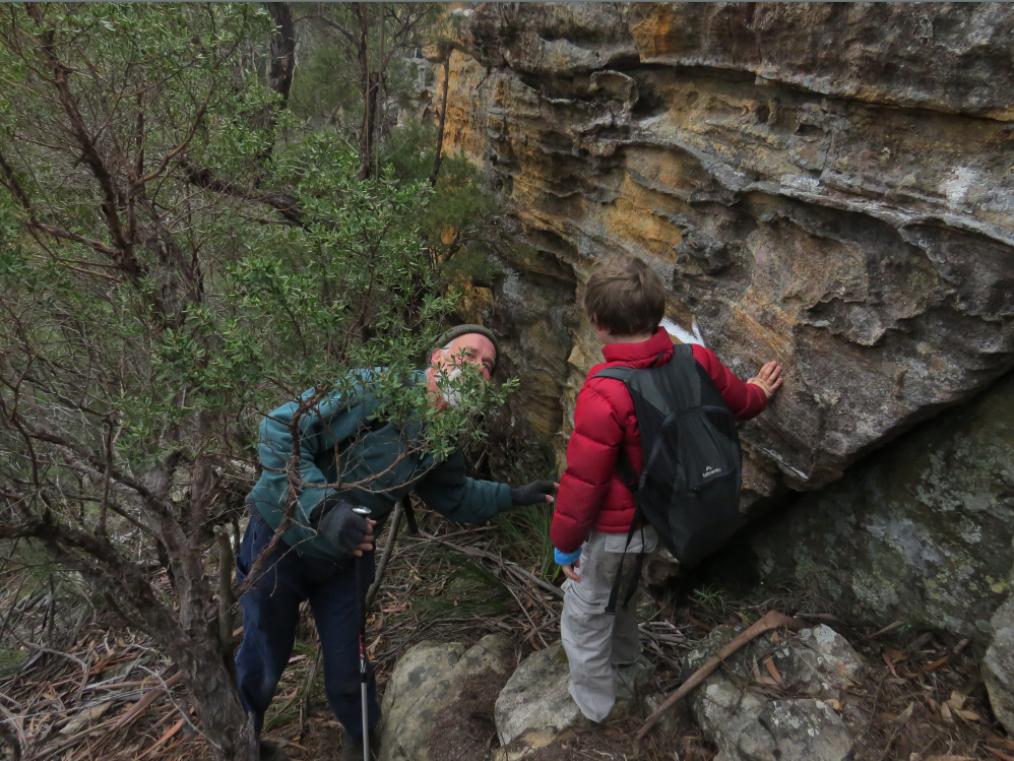 Exploring Elphinstone Plateau
[Photo © The Habitat Advocate, no reproduction permitted] Exploring Elphinstone Plateau
[Photo © The Habitat Advocate, no reproduction permitted]
The website is about to embark on a protracted conservation campaign to “Save Elphinstone Plateau” from Developer Wars – Book 3. The Habitat Advocate has its origins within walking distance of Elphinstone Plateau. We have explored it, but we know little of its ecology, its history, its Aboriginal heritage, its recurring struggles against selfish developer exploitation. So we are about to research all this and share our research journey on this website in the months to follow.
In doing so, we shall be shining a light on the stories of battles that have come before, back to the 1980s. This promises to stir skeletons from closets and to reveal facts that some would prefer were forgotten. For those interested in documentaries and reading history, our series of articles pursuing this conservation campaign will be an epic ride connecting the present to the past.
So after months of online hibernation, The Habitat Advocate is back in conservation action, awoken by a conservation warrior, asking us for support.
Elphinstone Plateau is where this website and logo were conceived.
Friday, October 10th, 2014
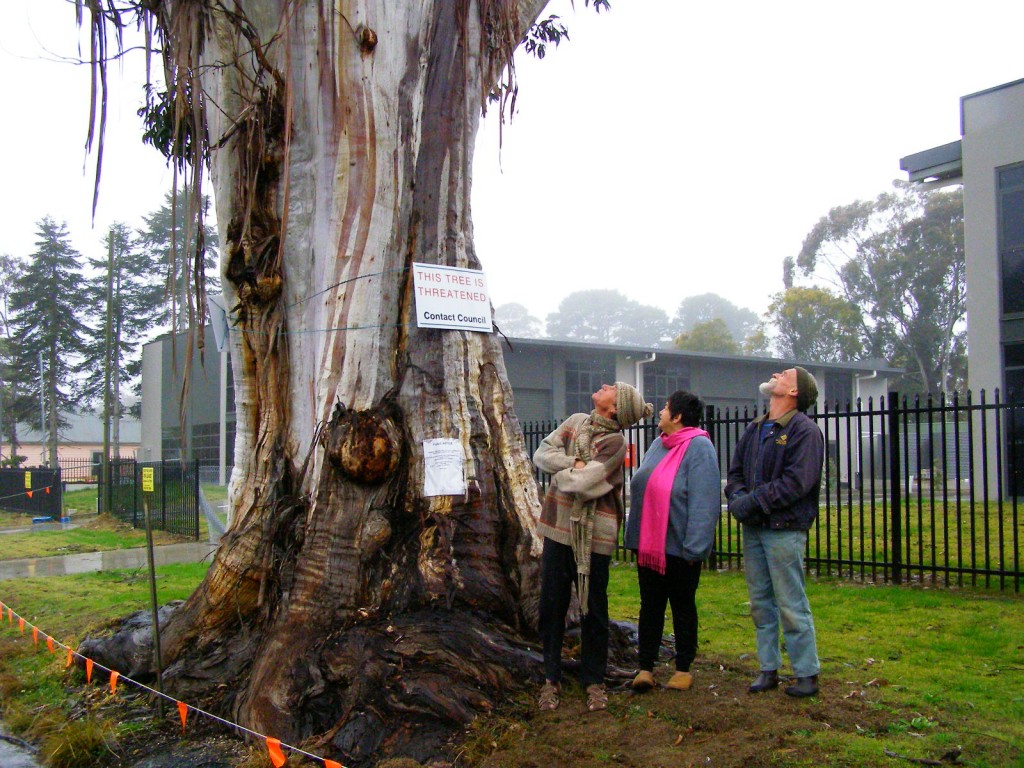 Katoomba residents Maureen and Peter Toy with Glenn Humphreys (right) marvel at Katoomba’s largest native tree
[Photo © Friends of Atlas, 20140907, click image to enlarge] Katoomba residents Maureen and Peter Toy with Glenn Humphreys (right) marvel at Katoomba’s largest native tree
[Photo © Friends of Atlas, 20140907, click image to enlarge]
.
Residents of the Blue Mountains, Maureen and Peter Toy, were shocked to learn last month about an arbitrary claim for this magnificent tree (pictured) to be killed for what they consider can be no rational reason.
According to advice that the Toys received from local conservation consultancy The Habitat Advocate, this large Blue Mountains Ash (Eucalyptus oreades) is a native tree only found in the Upper Blue Mountains. This particular specimen probably dates to 19th Century colonial settlement in Australia.
Maureen says “It is a beautiful and rare specimen and Blue Mountains folk are fortunate that we have such a significant tree still growing right by Megalong Street in now an increasingly industrialised part of Katoomba.”
Over the many decades, this great tree has withstood fierce windstorms, bushfires, road-widening right up to its trunk and industrial development all around it. With a canopy about 40 metres high and a trunk girth of over 5 metres, the tree has become a recognised icon and reference point in the area. It is home to a flock of sulphur-crested cockatoos.
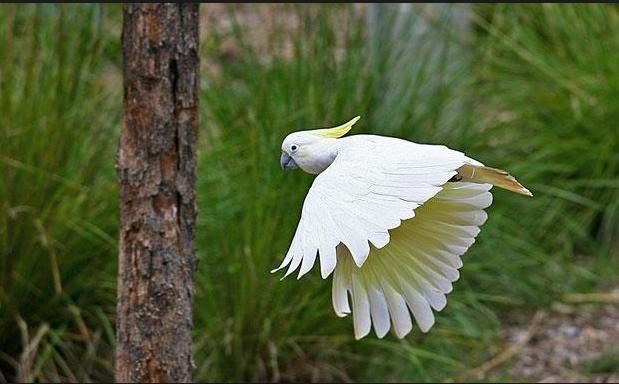 Sulphur-crested Cockatoo (Cacatua galerita)
These character parrots may be of ‘Least Concern’ to IUCN, but to the clan of cockies habitating Atlas, this is their home.
[Source: Zoos Victoria, ^http://www.zoo.org.au/healesville/animals/sulphur-crested-cockatoo] Sulphur-crested Cockatoo (Cacatua galerita)
These character parrots may be of ‘Least Concern’ to IUCN, but to the clan of cockies habitating Atlas, this is their home.
[Source: Zoos Victoria, ^http://www.zoo.org.au/healesville/animals/sulphur-crested-cockatoo]
.
Maureen affectionately calls the tree, ‘Atlas’, after the Greek God, for its towering size and for being so enduring. There is no other quite like it perhaps throughout the world renown Blue Mountains World Heritage Area.
Peter can’t understand why the tree is not on Council’s Significant Tree Register or why anyone would want to harm it. The tree is on community verge land and for the past few years there has been an industrial development constructed behind it. Peter and Maureen are vehemently opposed to any further harm being inflicted upon the tree and they have lodged a protest with council.
Several others in the local community have sided with the Toys and together have formed a local group ‘Friends of Atlas’ determined to protect the tree. Peter is looking to start a petition to garner local community recognition and support to protect the tree. He says “it is early days but he is ready for a sustained fight.”
A spokesperson from Blue Mountains (city?) Council has confirmed that the tree is situated on ‘Community Land‘ on the verdant verge strip between the street and the new industrial development at number 59 Megalong Street. The tree and its canopy and root system is not on private land, but on Community Land. Council has a duty as the community-delegated custodian of all community lands throughout the Blue Mountains Local Government Area. Council does not ‘own’ the tree per se, rather Council acts as the responsible custodian of this significant tree.
Council has stipulated in its development consent conditions for the adjoining industrial development application since 2010 that the tree must not be harmed by the current development activity.
But Peter disagrees. He says “guttering has been dug right into the tree roots system and just a month ago the developer had a bobcat grade the topsoil and roots around the tree for an entire day!.”
Council’s spokesperson says that council has not received any request for the tree to be destroyed.
A battle to save the tree is set to ensue.
.
Further Reading:
.
[1] Campaign Facebook Page: ^https://www.facebook.com/friendsofatlas
.
[2] Greater Blue Mountains World Heritage Area, ^http://whc.unesco.org/en/list/917
.
[3] Blue Mountains (city?) Council’s promotional tourism hypocrisy (or ‘greenwashing‘): ”
<<The Greater Blue Mountains World Heritage Area only exists today because of a 70-year campaign by conservationists to achieve a chain of reserves across the region. This culminated in the year 2000 with the acceptance of 10,000 square kilometres of wild bushland onto the World Heritage list – the ‘best of the best’.>>
Source: Blue Mountains (city?) Council, ^http://www.greaterbluemountainsdrive.com.au/
.
…70 years hence, this is the same reason why conservationists ‘Friends of Atlas’ have started a campaign. Atlas is the “best of the best”.
.
|
|




























